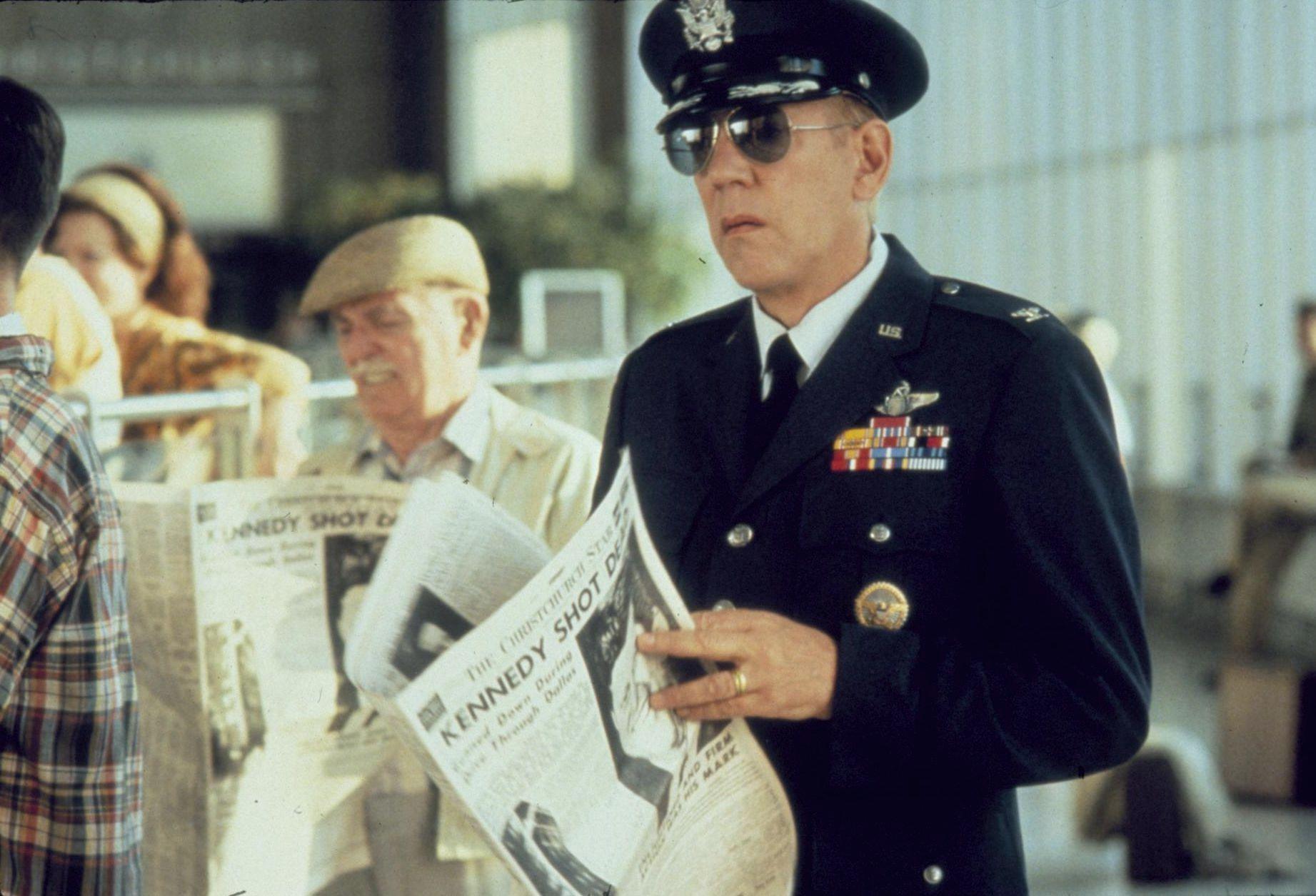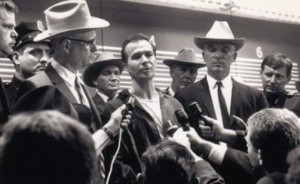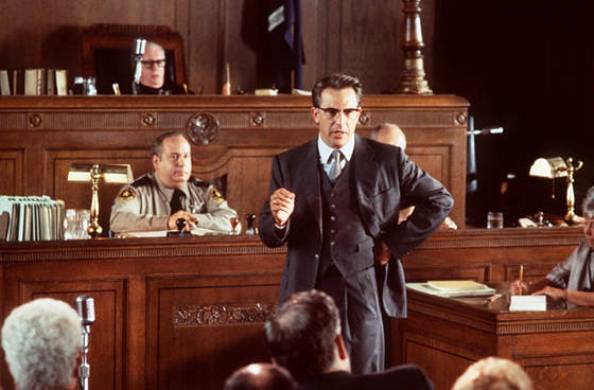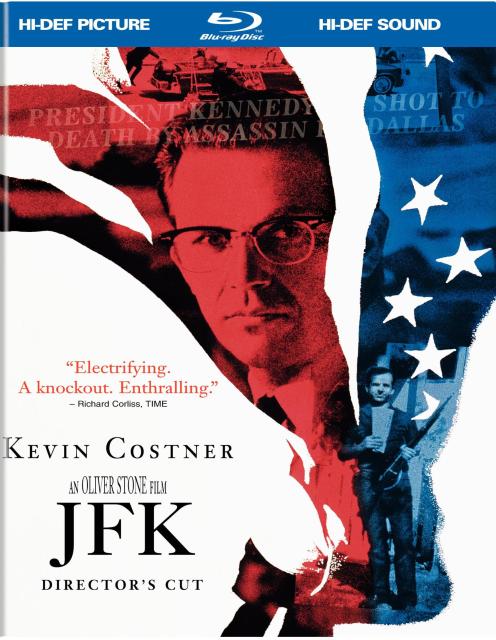
“FBI says they can prove it through physics in a nuclear laboratory. Of course they can prove it. Theoretical physics can also prove that an elephant can hang off a cliff with its tail tied to a daisy! But use your eyes, your common sense.” – Jim Garrison
Quintessential. JFK (1991) stands on its own as one of the most courageous films ever made both technically and topically, leaving durable imprints of societal impact. In the world of filmmaking, Oliver Stone’s film has most ardently influenced documentary films of today with their multimedia-layered probing – can you imagine “The Fog of War,” “Bowling for Columbine,” “No End in Sight,” “Why We Fight,” “Taxi to the Dark Side,” “The Corporation” and “The Ground Truth” existing without Stone’s influential hand?
The death of our 35th President John F. Kennedy, presented by Stone as an eternal mystery with no closure. Blending in different kinds  of film stock, arrays of lighting arrangements, and fusions of color and black & white, Stone employs a hallucinatory slipstream of visual styles to explicate information. Multi-dimensional evidence is so well-structured that belief of Lee Harvey Oswald (Gary Oldman) as the lone assassin theory dissolves. Henceforth, the implication of a Warren Commission cover-up becomes a logistical possibility.
of film stock, arrays of lighting arrangements, and fusions of color and black & white, Stone employs a hallucinatory slipstream of visual styles to explicate information. Multi-dimensional evidence is so well-structured that belief of Lee Harvey Oswald (Gary Oldman) as the lone assassin theory dissolves. Henceforth, the implication of a Warren Commission cover-up becomes a logistical possibility.
I’ve always noticed over the years that the people that have hated “JFK” have often been the same people who have never actually seen the film – exactly the kind of people I don’t like. One misconception is of the half-truths that the film is often accused of tossing around. To the film’s rebuttal the protagonist is forthright of what is fact and what is speculation. Yes, the film separates ideas of fact and speculation.
Revisiting Stone’s masterpiece, I am most staggered by one aspect above anything else. The closing courtroom arguments by Jim Garrison (Kevin Costner) in the courtroom reflects the kind of controversial head-banging that exists between left and right wing today.
“What National Security permits the removal of fundamental power from the hands of the American people and validates the ascendancy of an invisible government in the United States? That kind of national security is when it smells like it, feels like it, and looks like it…you call it what it is: Fascism.
Garrison continues.
“The war is the biggest business in America worth $80 billion a year. President Kennedy was murdered by a conspiracy that was planned at the highest levels of our government and was carried out by fanatical and disciplined cold warriors in the Pentagon and CIA’s cover-operation apparatus.” (February 1969)
To have a character say such words in a motion picture was a massive shock to the system, one that rippled into the world outside the movie theater. Boldly, the statement challenges “liberty” and “freedom” as propaganda words. A film like “JFK” was a watershed to modern liberal thinking (is that a good thing or a bad thing?). We understand the spider webs of corruption in high office better today because we understand the machine better – a lot of that is due to what we learned from “JFK,” and from other Stone films like “Wall Street,” “Born on the 4th of July” and “Nixon.”
 Of course District Attorney Jim Garrison never really got after the wide-range of conspirators he desired to, only accomplishing to put Clay Shaw (Tommy Lee Jones, never more different) on trial as a CIA agent complicit to the assassination. What Garrison succeeded at was to provoke national controversy and incite, gosh, opinion and discourse. Costner’s performance is the anchor of the film as he is required to communicate long monologues with vast and potentially incalculable information and yet makes it lucid and digestible. In addition, Oscar winning cinematography (Robert Richardson) and film editing (Joe Hutshing, Pietro Scalia) are among the best of the craft ever committed to a motion picture.
Of course District Attorney Jim Garrison never really got after the wide-range of conspirators he desired to, only accomplishing to put Clay Shaw (Tommy Lee Jones, never more different) on trial as a CIA agent complicit to the assassination. What Garrison succeeded at was to provoke national controversy and incite, gosh, opinion and discourse. Costner’s performance is the anchor of the film as he is required to communicate long monologues with vast and potentially incalculable information and yet makes it lucid and digestible. In addition, Oscar winning cinematography (Robert Richardson) and film editing (Joe Hutshing, Pietro Scalia) are among the best of the craft ever committed to a motion picture.
With Joe Pesci, Kevin Bacon, John Candy, Jack Lemmon, Walter Matthau, Michael Rooker, Sissy Spacek, Laurie Metcalf and Donald Sutherland as Mr. X.
189 Minutes. Rated R.
Film Cousins: “Wall Street” (1987); “Ruby” (1992); “Nixon” (1995); “W.” (2008).






